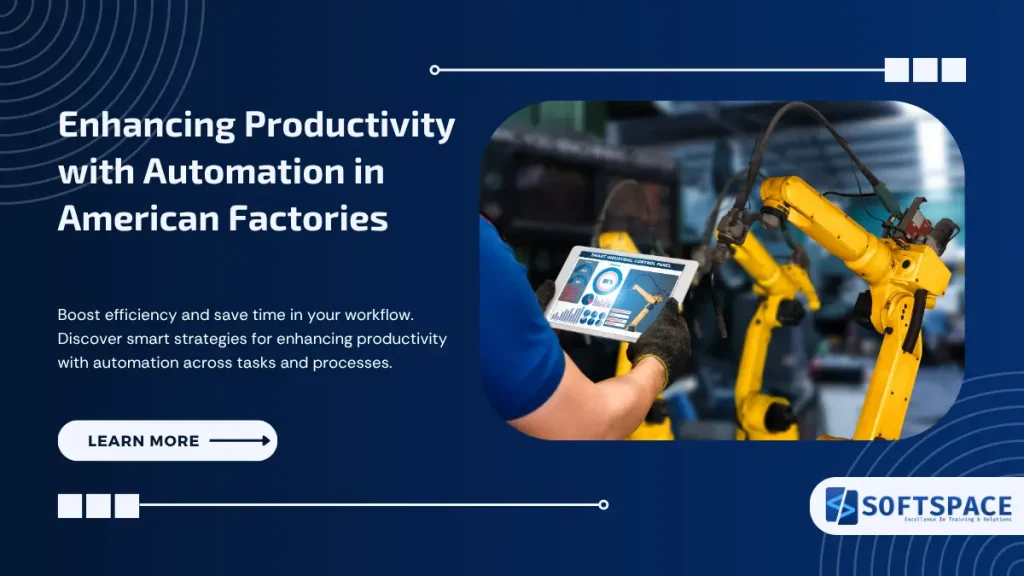Want to know the secret behind America’s manufacturing comeback?
American factories are experiencing a productivity revolution that’s changing everything. From small family-owned shops to massive production facilities, automation is transforming how things get made. The numbers don’t lie either.
Here’s the thing: Manufacturing automation statistics USA reveal a stunning transformation happening right under our noses. Companies that embrace automation aren’t just surviving in today’s competitive market – they’re absolutely crushing it. Advanced platforms like Omega AI are helping businesses understand these trends and make smarter automation decisions, and are helping in enhancing productivity with automation.
But why are smart factory owners rushing to automate their operations? The answer might surprise you.


What’s cooking in this deep dive?
- Why American Factories Are Going All-In on Automation
- The Numbers That Will Blow Your Mind
- Real-World Success Stories You Haven’t Heard
- What This Means for Factory Owners Like You
Why American Factories Are Going All-In on Automation
Let’s cut to the chase. American manufacturing is experiencing something incredible right now.
The global industrial automation market is exploding. We’re talking about growth that’s expected to reach $569.27 billion by 2034. That’s not just growth – that’s a complete transformation of how Americans make stuff.
Here’s what’s driving this automation boom:
Factory owners are dealing with serious labour shortages that keep getting worse. Finding skilled workers has become nearly impossible in many areas, and the situation isn’t improving anytime soon. When you can’t find the people, you need the machines to pick up the slack.
The technology finally makes sense financially for operations of all sizes. Advanced robots and AI systems that used to cost millions are now affordable for medium-sized operations. The return on investment happens faster than most business owners expected, sometimes paying for itself within just two years.
Competition from overseas manufacturers is fiercer than ever before. The only way American factories can compete with lower-cost foreign production is through superior efficiency and quality that manual processes simply can’t deliver. Automation delivers both consistently.
Customer expectations have changed dramatically across every industry. Everyone wants faster delivery, better quality, and lower prices – all at the same time. Manual processes just can’t keep up with these demands anymore, especially when competitors are using automation to exceed customer expectations.
Enhancing Productivity with Automation: The Numbers
- 86% of industrial companies worldwide are using automation to improve productivity. That’s not just a trend – that’s a complete industry shift.
- But here’s where it gets really interesting…
- Manufacturing industries’ output increased by 3.1% on average every year from 2011 to 2016 as a result of automation. That consistent growth happened during a period when many factories were struggling to stay competitive.
- The productivity gains are even more impressive. 90% of firms have reported a significant increase in productivity with the application of process automation. These aren’t small improvements either – we’re talking about game-changing efficiency boosts.
And here’s the kicker: Businesses choosing to automate saw a 30% higher average growth rate than those relying on manual processes. That’s the difference between thriving and barely surviving in today’s market.
Real-World Success Stories You Haven’t Heard
The best part about automation isn’t the fancy technology – it’s the real results happening in factories across America right now.
Take the automotive industry, for example. Tesla used digitalisation technologies to go from groundbreaking to production in just two years at their Texas plant. That timeline would have been completely impossible without advanced automation systems working around the clock.
In Kentucky, Henkel optimised their storage operations using digital automation systems that most people never hear about. The result? Significant profit increases and streamlined operations that free up workers for more valuable, strategic tasks that require human creativity.
Michigan’s electric vehicle battery facilities showcase another incredible success story that’s reshaping American manufacturing. These plants combine federal and state incentives with $200 million in private investments, all centred around automated production systems that operate with precision humans simply can’t match.
But it’s not just the big players seeing results.
Medium-sized manufacturers across the country are implementing automation solutions and seeing immediate improvements in quality control, production speed, and cost management. These companies are proving that automation isn’t just for Fortune 500 corporations anymore – it’s becoming accessible to businesses of all sizes that want to stay competitive.
What This Means for Factory Owners Like You
The automation revolution isn’t coming – it’s here right now.
Manufacturing executives understand this reality. That’s why 86% of them are confident that smart factory solutions will be the primary drivers of competitiveness over the next five years.
Here’s what factory owners need to know:
- The U.S. Industrial Process Automation Market is expected to reach $21.88 billion by 2030. This growth represents massive opportunities for businesses that position themselves correctly.
- Labour challenges aren’t going away. Nearly half of manufacturers report moderate to significant challenges filling production and operations management roles. Automation provides a solution to this persistent problem.
- The technology keeps getting better and more affordable. What seemed impossible just a few years ago is now standard practice in many facilities.
- Customer demands will continue increasing. Faster delivery times, higher quality standards, and competitive pricing require the efficiency that only automation can provide.
The Competitive Advantage Smart Factories Are Building
American factories using automation aren’t just improving their operations – they’re building sustainable competitive advantages that will last for decades.
The benefits extend far beyond simple cost savings:
- Quality control reaches new levels of precision. Automated systems can detect defects and inconsistencies that human workers might miss. This leads to better products and fewer customer complaints.
- Production flexibility increases dramatically. Modern automated systems can switch between different products quickly, allowing manufacturers to respond to market changes faster than ever before.
- Safety improvements protect workers and reduce liability. Automated systems handle dangerous tasks and heavy lifting, creating safer working environments.
- Data collection and analysis capabilities provide insights that drive continuous improvement. Every aspect of production can be monitored, measured, and optimised.
Wrapping Up the Automation Revolution
The manufacturing automation revolution is transforming American factories in ways that seemed impossible just a decade ago. From productivity gains to competitive advantages, automation is delivering results that are reshaping entire industries.
The statistics paint a clear picture. Companies that embrace automation see higher growth rates, better productivity, and stronger competitive positions. Those that resist automation risk being left behind in an increasingly competitive global marketplace.
The bottom line is simple: Automation isn’t just changing how American factories operate – it’s determining which ones will thrive in the years ahead. The factories that invest in automation today are building the foundation for sustained success tomorrow.
Smart factory owners understand that automation isn’t just about replacing workers with machines. It’s about creating more efficient, flexible, and competitive operations that can adapt to changing market conditions while delivering the quality and speed that modern customers demand.
The question isn’t whether automation will transform American manufacturing – it’s already happening. The real question is whether your factory will be part of this revolution or watching from the sidelines.
Softspace Solutions is focused on the all-around development of professionals who can contribute towards the strategic success of any firm they join. We make sure that professionals develop the skills required to stay relevant in today’s globalised and complex world.



